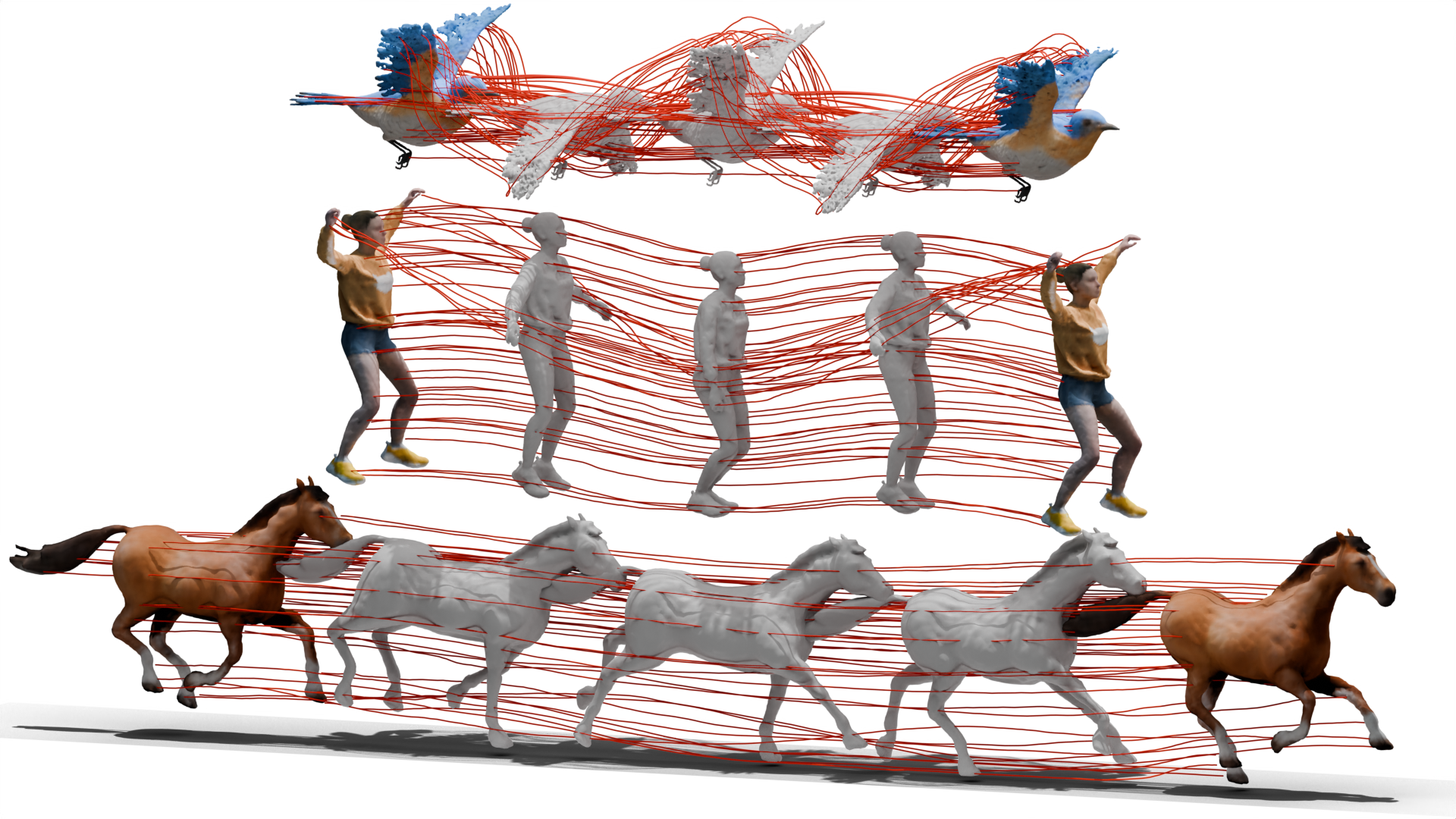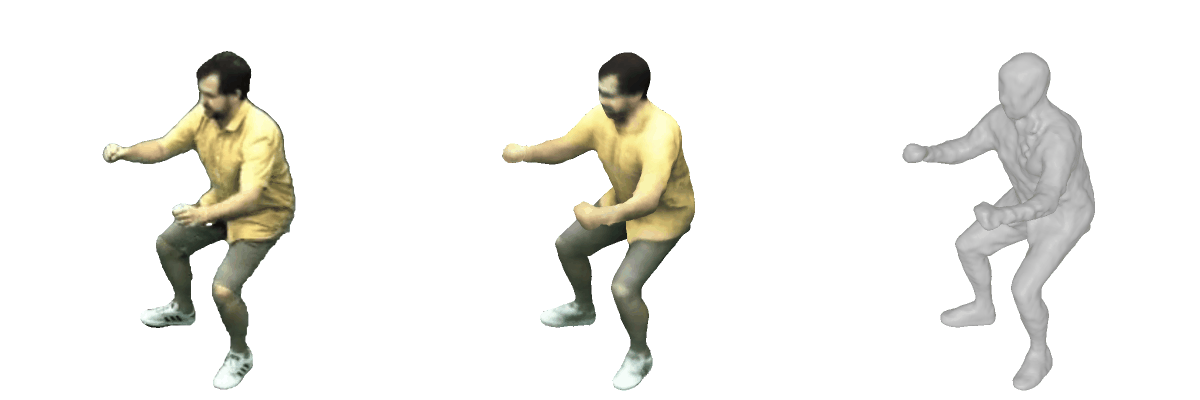We propose DG-Mesh, a framework that reconstructs high-fidelity time-consistent mesh from monocular videos. Given monocular inputs of dynamic scenes and the camera parameters, our method reconstructs the high-quality surface and its appearance, as well as the mesh vertice motion across time frames. Our method can reconstruct mesh with flexible topology change. We can reconstruct satisfying surfaces even in challenging thin structures like bird wings.
- Installation instructions
- Training/inference code
- Mesh evaluation code
- DG-Mesh dataset
- Mesh correspondence visualization
conda create -n dg-mesh python=3.9
conda activate dg-mesh
conda install pytorch torchvision torchaudio pytorch-cuda=11.8 -c pytorch -c nvidia
# Install nvdiffrast
pip install git+https://github.com/NVlabs/tiny-cuda-nn#subdirectory=bindings/torch
pip install git+https://github.com/NVlabs/nvdiffrast/
# Install pytorch3d
export FORCE_CUDA=1
conda install -c fvcore -c iopath -c conda-forge fvcore iopath -y
pip install "git+https://github.com/facebookresearch/pytorch3d.git"
# Clone this repository
git clone https://github.com/Isabella98Liu/DG-Mesh.git
cd DG-Mesh
# Install submodules
pip install dgmesh/submodules/diff-gaussian-rasterization
pip install dgmesh/submodules/simple-knn
# Install other dependencies
pip install -r requirements.txt
We provide the config files to train our model on the D-NeRF dataset. Download the datasets and change the source_path in the corresponding config files:
python dgmesh/train.py --config dgmesh/configs/d-nerf/jumpingjacks.yaml
We also provide rendering script to visualize the mesh and its rendering results, as well as the Gaussian points from the trained model. Set the --start_checkpoint to the path of your trained model. For example:
python dgmesh/render_trajectory.py --config dgmesh/configs/d-nerf/jumpingjacks.yaml --start_checkpoint outputs/d-nerf/jumpingjacks/jumpingjacks-2024-07-01_06-03-50
Example of mesh rendering results and Gaussians points on D-NeRF dataset.
To evaluate the reconstructed mesh quantitatively, we provide a synthetic dataset containing six dynamic scenes. Each scene includes 200 frames of a moving object with the ground truth camera parameters and images, as well as the ground truth mesh under each time frame. You can download the DG-Mesh dataset following the link provided. The data format follows the D-NeRF dataset.
To train the model, revise the source_path in the corresponding config files and run the following command:
python dgmesh/train.py --config dgmesh/configs/dg-mesh/beagle.yaml
Example of mesh rendering results and Gaussians points on DG-Mesh dataset.
We provide part of the processed Nerfies data, which additionally contains the object foreground masks; you can download them here in the release page. To train the model on the Nerfies dataset, run the following command:
python dgmesh/train.py --config dgmesh/configs/nerfies/toby-sit.yaml
To render the mesh under the testing camera views, run the following scripts:
python dgmesh/render_test.py --config /mnt/samsung990/ECCV2024/Release/DG-Mesh/dgmesh/configs/nerfies/toby-sit.yaml --start_checkpoint outputs/nerfies/toby-sit/toby-sit-2024-07-04_22-56-29
The NeuralActor dataset is a multi-view dynamic dataset that contains multi-view videos of moving humans. We process part of the dataset (will release the processed data if approved). To run the model on the NeuralActor dataset:
python dgmesh/train.py --config dgmesh/configs/neural-actor/D2_vlad.yaml
We capture several dynamic scenes using iPhone 14 Pro and Record3D, and process them using the pipeline in Reality Check. We use DEVA to obtain our foreground masks. You can download the data through the link in the release page. To train the model on our captured data, run:
python dgmesh/train.py --config /dgmesh/configs/iphone/tiger.yaml
We provide the mesh evaluation script on the DG-Mesh dataset; please organize the mesh GT data and your mesh results like below:
mesh_eval_folder/
├── gt/
│ ├── objname0.obj
│ ├── objname1.obj
│ └── ...
├── DG-Mesh/
│ └── dynamic_mesh/
│ ├── frame_0.ply
│ ├── frame_1.ply
│ └── ...
└── transforms_train.json
You may need to install StructuralLoss to calculate the EMD; please follow the instruction below:
cd dgmesh/metrics/pytorch_structural_losses/
make clean
make
To run the evaluation:
python mesh_evaluation.py --path mesh_eval_folder --eval_type dgmesh
If you find our code or paper helps, please consider citing:
@misc{liu2024dynamic,
title={Dynamic Gaussians Mesh: Consistent Mesh Reconstruction from Monocular Videos},
author={Isabella Liu and Hao Su and Xiaolong Wang},
year={2024},
eprint={2404.12379},
archivePrefix={arXiv},
primaryClass={cs.CV}
}
And thanks to the authors of Deformable 3DGS and 3DGS for their excellent code!









